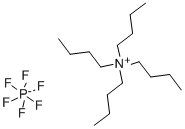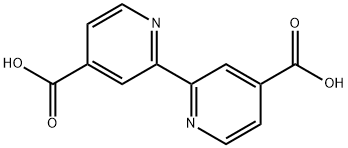Bis(tetrabutylammonium) Dihydrogen Bis(isothiocyanato)bis(2,2'-bipyridyl-4,4'-dicarboxylato)ruthenium(II) , 90%(HPLC) , 207347-46-4
Synonym(s):
N-719 dye
CAS NO.:207347-46-4
Empirical Formula: 2C16H36N.2C12H7N2O4.C2N2RuS2
Molecular Weight: 1188.57
MDL number: MFCD11042475
| Pack Size | Price | Stock | Quantity |
| 100MG | RMB599.20 | In Stock |
|
| 250mg | RMB1184.80 | In Stock |
|
| 1G | RMB3559.20 | In Stock |
|
| others | Enquire |
PRODUCT Properties
| Melting point: | 250-260°C |
| storage temp. | under inert gas (nitrogen or Argon) at 2–8 °C |
| form | Solid |
| color | Black |
| λmax | 534393313 nm (lit.) |
| Stability: | Light Sensitive |
| CAS DataBase Reference | 207347-46-4 |
| solubility | Ethanol or acetonitrile/tert-butanol (1:1, v:v) |
Description and Uses
Di-tetrabutylammonium cis-bis(isothiocyanato)bis(2,2′-bipyridyl-4,4′-dicarboxylato)ruthenium(II), N719 dye, is the ammonium salt of N3 dye.?With changes to increase cell voltage and solubility in polar solvents comparing with N3 dye, N719 dye is also one of the most common high performance dyes that are developed for DSSC solar cells.
N-719 dye is widely used as a sensitizer that can be coated on indium tin oxide (ITO) substrates by doctor blade technique, with different photoanode materials like titanium oxide (TiO2), zinc oxide (ZnO), and gold nanourchin for dye sensitized solar cell (DSSC) applications.
Safety
| Symbol(GHS) |  GHS08 |
| Signal word | Danger |
| Hazard statements | H334 |
| Precautionary statements | P261-P342+P311 |
| Hazard Codes | Xn |
| Risk Statements | 42/43 |
| Safety Statements | 22-36/37-45 |
| WGK Germany | 3 |
| HS Code | 28439000 |



![4'-Methyl-[2,2'-bipyridine]-4-carboxylicacid](https://img.chemicalbook.com/CAS/GIF/103946-54-9.gif)

![[2,2'-Bipyridine]-4,4'-dicarbaldehyde](https://img.chemicalbook.com/CAS/GIF/99970-84-0.gif)
![4'-Methyl-[2,2'-bipyridine]-4-carbaldehyde](https://img.chemicalbook.com/CAS/GIF/104704-09-8.gif)